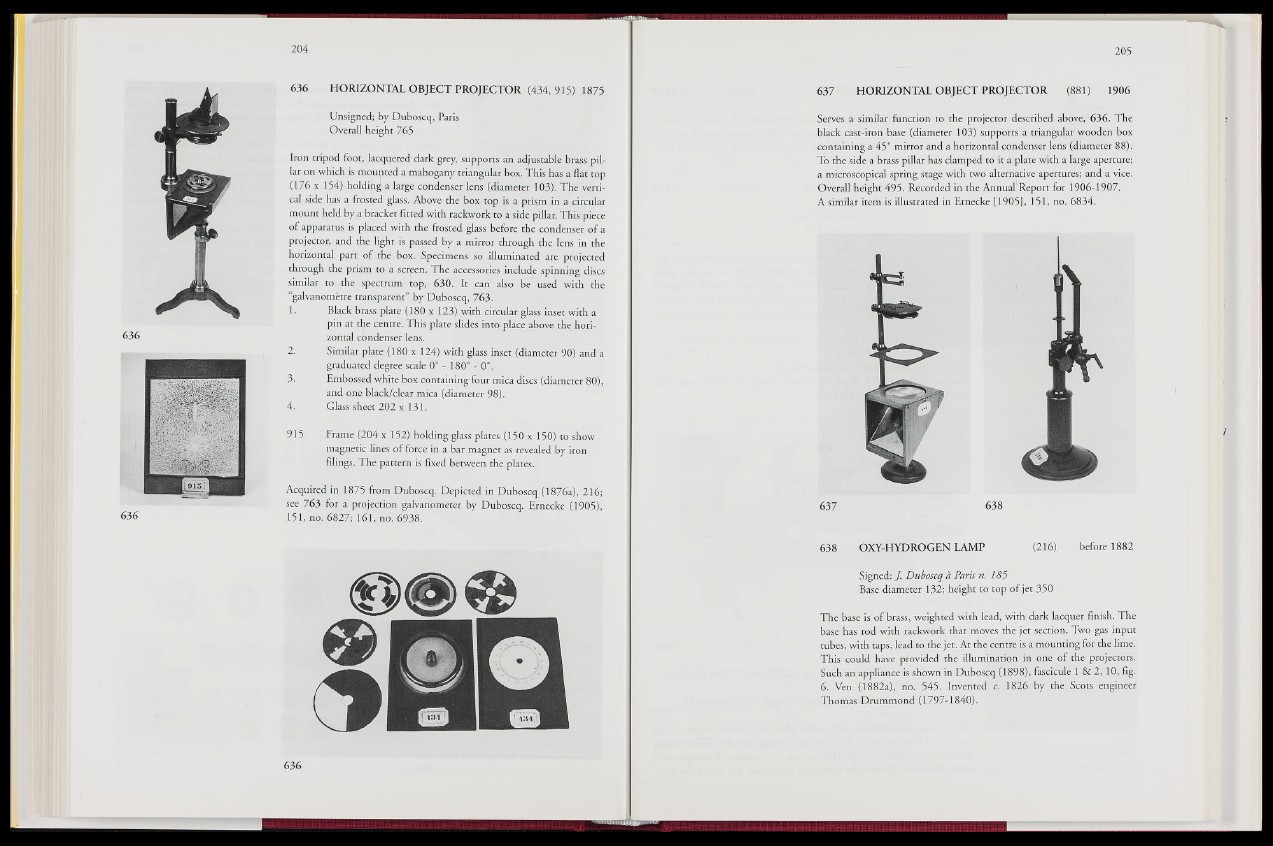
636
636 HORIZONTAL OBJECT PROJECTOR (434,915) 1875
Unsigned; by Duboscq, Paris
Overall height 765
Iron tripod foot, lacqqered dark grey, supports an adjustableilrass pillar
on which is mounted a mahogany triangular box. This has a flat top
(176 x 154) holding a large condenser lens (diameter 103). The vertical
side has a frost|ed glass. Above the box top is a prism in a circular
mount held by a bracket fitted with rackwork to a side pillar. This piece
of apparatus is placed with the frosted glass before the condenser of a
projector, and the light is passed by a mirror through the lens in the
horizontal part of the box. Specimens so illuminated are projected
through the prism to a screen. The accessories include spinning discs
similar to the spectrum top, 630. It can also be used with the
“galvanomètre transparent” by Duboscq, 763.
1. Black brass plate (180 x 123) with circular glass inset with a
pin at the centre. This plate slides into place above thehori-
zontal condenser lens.
2. Similar plate (180 x 124) with glass inset (diameter 90) and a
graduated degree scale 0 s - 180K 0 °.
3. i Embossed white box containing four mica discs (diameter 80),
and one black/clear mica (diameter 98).
4. Glass sheet 202 x l3 l'j|
915 Frame (204 x 152) holding glass plates (150 x 150) to show
magnetic lines of force in a bar magnet as revealed by iron
filings. The pattern is fixed between the plates.
Acquired in 1875 from Duboscq. Depicted in Duboscq||876a), 216;
see 763 for a projection galvanometer by Duboscq. Emecke (1905),
151, no. 6827; 161, no. 6938.
637 HORIZONTAL OBJECT PROJECTOR (881) 1906
Serves a similar function to the projector described above, 636. The
black cast-iron base (diameter 103) supports a triangular wooden box
containing a 45° mirror and a horizontal condenser lens (diameter 88).
To the side a brass pillar has clamped to it a plate with a large aperture;
a microscopical spring stage with two alternative apertures; and a vice.
Overall height 495. Recorded in the Annual1 Report for 1906-1907.
A similar item is illustrated in Ernecke [1905], 151, no. 6834.
637 638
638 OXY-HYDROGEN LAMP (216) before 1882
Signed: J. Duboscq a Paris n. 185
Base diameter 132; height to top of jet 350
The base is of brass, weighted with lead, with dark lacquer finish. The
base has rod with rackwork that moves the jet section. Two gas input
tubes, with taps, lead to the jet. At the centre is a mounting for the lime.
This could have provided the fflumination in one of the projectors.
Such an appliance is shown in Duboscq (1898), fascicule 1 & 2, 10, fig.
6. Yeh|1882h|i“no. 545. Invented c. 1826 by the Scots engineer
Thomas Drummond (.1797-1840).